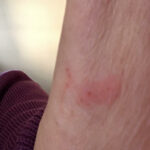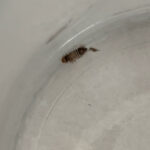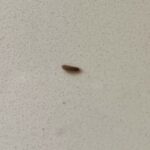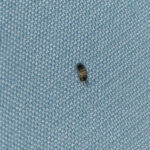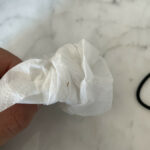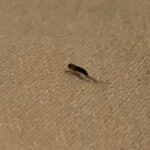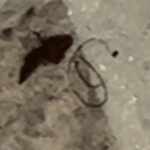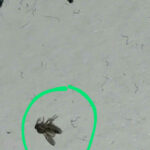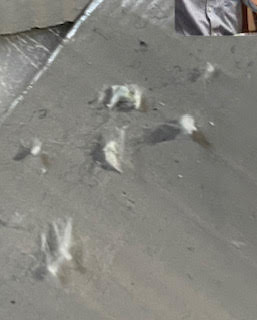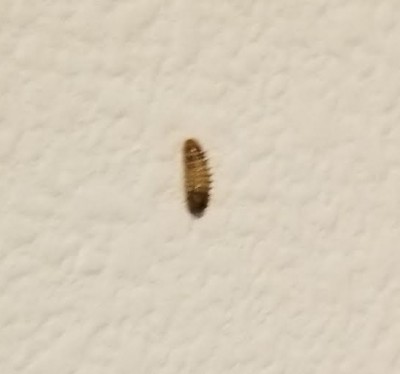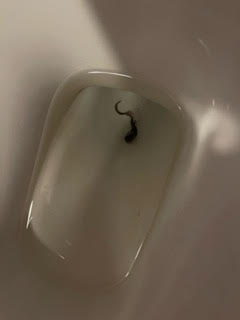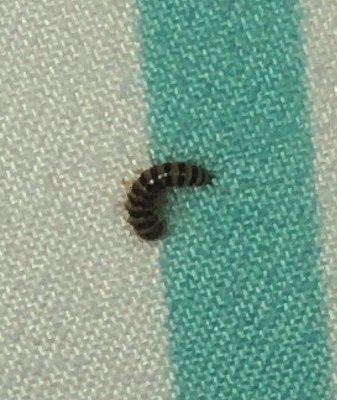
A reader recently sent in this image of a creature, asking us to confirm whether or not it is a carpet beetle larva. The creature in question appears black and gray-striped, with a black head, and a double-pronged tail. In comparison to the fibers of the material this worm was found on, we can presume that this worm is tiny in size.
First and foremost, we wish to thank our reader for sending such a clear and crisp quality image of the creature she found. Secondly, we also want to thank her for helping us narrow down the options of what this creature might be by giving her own shot at identifying the worm. Thirdly, we do indeed think this little critter is a carpet beetle larva. Carpet beetle larvae tend to be 4-5mm in length, according to Orkin, and have coarse hair sprouting from their bodies. If one looks close enough at the image above, one can make out the hairs against the backdrop of the fabric. They are also indeed striped, and are usually yellow/tan and brown, but can also be black and gray as in this case.
Carpet beetle larvae are considered household pests. This means that they regularly invade households and can, to a certain extent, cause damage to the home. The harm that carpet beetle larvae cause to one’s home comes as a result of their diet: animal-based textiles. They are often found feeding on carpets, which is where they get their name, but can also be found eating clothes, curtains, and upholstered furniture, such as couches, chairs, and ottomans. Infestations of carpet beetle larvae can occur, and it is, in fact, in their larval stage that these creatures do the most damage, which is true for most fabric-eating insects. For this reason, our reader will want to ensure she acts on this immediately!
To remove the carpet beetle larvae, we encourage our reader to locate the source of the carpet beetle infestation. This entails searching for the eggs, larvae, and/or cast skins of the carpet beetle in environments that would best suit them, which are usually dark, enclosed spaces where they can feed on fabrics in peace. Hence, we suggest looking in the folds of clothing, in or underneath carpets, or underneath and behind upholstered furniture. Eggs can even be found in cracks in walls near a possible food source. The next step would then be to vacuum up the eggs and larvae found, and then to launder all infested fabrics with extremely hot water. This will eliminate any excess eggs or larvae that may not have been vacuumed up. Even if our reader is unable to identify the source, she can still deal with the infestation, but the clean up will just be on a larger scale; she will want to vacuum her entire home, as well as launder all animal-based fabrics to ensure that all potential habitats of carpet beetle larvae are accounted for. This might even be a good idea if the source is located. Better safe than sorry!
Furthermore, if our reader is facing an infestation, and the carpet beetle larvae have already entered, or are about to enter adulthood (which can take two to three weeks, according to the Entomology and Nematology department at the University of Florida), she should still rid her home of the carpet beetles. Although they do the most damage during their larval stage, and the primary diet of full-grown carpet beetles consists of nectar and pollen, according to Orkin, carpet beetles, if present in the home, may turn to feeding on food items in the kitchen such as rice, flour and cereals.
In conclusion, the creature that our reader photographed is indeed a carpet beetle larva. As previously stated, these creatures are pests, and infestations can occur, so we encourage our reader to follow the instructions above and resolve this infestation as soon as possible.
All About Worms is always free, always reader-supported. Your tips via CashApp, Venmo, or Paypal are appreciated! Receipts will come from ISIPP Publishing.
You might also find these guys interesting!





